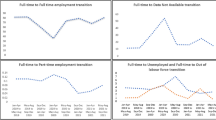Abstract
This paper studies gross labour market flows and determinants of labour market transitions for urban Indian workers using a panel dataset constructed from Indian Periodic Labour Force Survey (PLFS) data for the period 2017–18 to 2019–20. Longitudinal studies based on the PLFS have been hampered by data problems that prevent a straightforward merging of the 2017–18 and 2018–19 data releases. In this paper, we propose and validate a matching procedure based on individual and household characteristics that can successfully link almost all records across these 2 years. We use the constructed dataset to document a number of stylised facts about gross worker flows and to estimate the effects of different individual characteristics and work histories on probabilities of job gain and loss.



Similar content being viewed by others
Notes
Given that each person is followed over four quarters, age in years should not change by more than 1. However, examination of the reported age distribution shows significant bunching around multiples of 2 and 5 which suggests imprecise reporting of age. Since the purpose of this step is only to prevent incorrect linking, we keep a wider acceptance range for reported age.
The self-employment category includes unpaid family workers whose incomes are recorded as zero and whose income can only increase when they move to another state.
References
Abdul-Razak, S. and S. Sahoo. 2021. Using the rotational panel data from the Periodic Labour Force Survey: A cautionary tale. Available at SSRN.
Abowd, J.M. and A. Zellner. 1985. Estimating gross labor-force flows. Journal of Business & Economic Statistics 3 (3): 254–283.
Ahn, H.J., and J.D. Hamilton. 2021. Measuring labor-force participation and the incidence and duration of unemployment. Review of Economic Dynamics 44: 1–32.
Blanchard, O.J., P. Diamond, R.E. Hall and K. Murphy. 1990. The cyclical behavior of the gross flows of US workers. Brookings Papers on Economic Activity 1990 (2): 85–155.
Burda, M. and C. Wyplosz. 1994. Gross worker and job flows in Europe. European Economic Review 38 (6): 1287–1315.
CSO. 2008. National industrial classification (all economic activities). Government of India: Central Statistical Organisation.
Davis, S.J., R.J. Faberman and J. Haltiwanger. 2006. The flow approach to labor markets: New data sources and micro-macro links. Journal of Economic Perspectives 20 (3): 3–26.
Davis, S.J. and J. Haltiwanger. 1992. Gross job creation, gross job destruction, and employment reallocation. The Quarterly Journal of Economics 107 (3): 819–863.
Davis, S.J., J.C. Haltiwanger and S. Schuh. 1998. Job creation and destruction. The MIT Press.
Deshpande, A. and J. Singh. 2021, Dropping out, being pushed out or can’t get in? Decoding declining labour force participation of Indian women. Ashoka University Economics Discussion Paper 65.
Elsby, M.W., B. Hobijn and A. Şahin. 2013. Unemployment dynamics in the OECD. Review of Economics and Statistics 95 (2): 530–548.
Enevoldsen, N. 2022. Twitter thread. https://twitter.com/NilsEnevoldsen/status/1520967332654624768.
Feng, S. and Y. Hu. 2013. Misclassification errors and the underestimation of the US unemployment rate. American Economic Review 103 (2): 1054–70.
Fujita, S. and G. Ramey. 2009. The cyclicality of separation and job finding rates. International Economic Review 50 (2): 415–430.
Gallego, F.A. and J.A. Tessada. 2012. Sudden stops, financial frictions, and labor market flows: Evidence from Latin America. Journal of Development Economics 97 (2): 257–268.
Hall, R.E. 2005. Job loss, job finding, and unemployment in the US economy over the past fifty years. NBER Macroeconomics Annual 20: 101–137.
Hall, R.E. and M. Kudlyak. 2019. Job-finding and job-losing: A comprehensive model of heterogeneous individual labor-market dynamics. National Bureau of Economic Research, Working Paper No. 25625.
Manski, C.F. 2009. Identification for prediction and decision. Harvard University Press.
Menon, R. and P. Nath. 2022. A dynamic analysis of women’s labour force participation in urban India. The Economic and Labour Relations Review 33 (4): 766–785.
Mitra, A., P.K. Shrivastav and G.P. Singh. 2022. Livelihood volatility in the urban labour market. Economic & Political Weekly 57 (35): 63.
Mitra, A. and Y. Tsujita. 2016. Issues in upward mobility: Study based on longitudinal data from Delhi slums. Habitat International 53: 320–330.
NSSO. 2016. Periodic Labour Force Survey: Instructions to field staff, vol. I. Government of India: National Sample Survey Office.
Rogerson, R. and R. Shimer. 2011. Search in macroeconomic models of the labor market. In Handbook of labor economics, vol. 4, ed. O. Ashenfelter and D. Card, 619–700. Elsevier.
Sarkar, S., S. Sahoo and S. Klasen. 2019. Employment transitions of women in India: A panel analysis. World Development 115: 291–309.
Shimer, R. 2005. The cyclical behavior of equilibrium unemployment and vacancies. American Economic Review 95 (1): 25–49.
Shimer, R. 2012. Reassessing the ins and outs of unemployment. Review of Economic Dynamics 15 (2): 127–148.
Yassine, C. 2015. Job accession, separation, and mobility in the Egyptian labor market over the past decade. In The Egyptian labor market in an era of revolution, ed. R. Assaad and C. Krafft, 218–240. Oxford University Press.
Funding
No funding was received for conducting this study and preparing this manuscript.
Author information
Authors and Affiliations
Corresponding author
Ethics declarations
Conflict of interest
The author has no relevant financial or non-financial interests to disclose.
Additional information
Publisher's Note
Springer Nature remains neutral with regard to jurisdictional claims in published maps and institutional affiliations.
I am grateful to the two anonymous referees, seminar participants at Centre for Sustainable Employment (Azim Premji University) and Ambedkar University Delhi, and to Ishan Anand and Anamitra Roychowdhury for very helpful comments. An earlier version of this paper was circulated as the working paper https://arxiv.org/abs/2110.05482.
Rights and permissions
Springer Nature or its licensor (e.g. a society or other partner) holds exclusive rights to this article under a publishing agreement with the author(s) or other rightsholder(s); author self-archiving of the accepted manuscript version of this article is solely governed by the terms of such publishing agreement and applicable law.
About this article
Cite this article
Bhattacharya, J. Indian Urban Workers’ Labour Market Transitions. Ind. J. Labour Econ. 66, 471–494 (2023). https://doi.org/10.1007/s41027-023-00434-9
Accepted:
Published:
Issue Date:
DOI: https://doi.org/10.1007/s41027-023-00434-9




